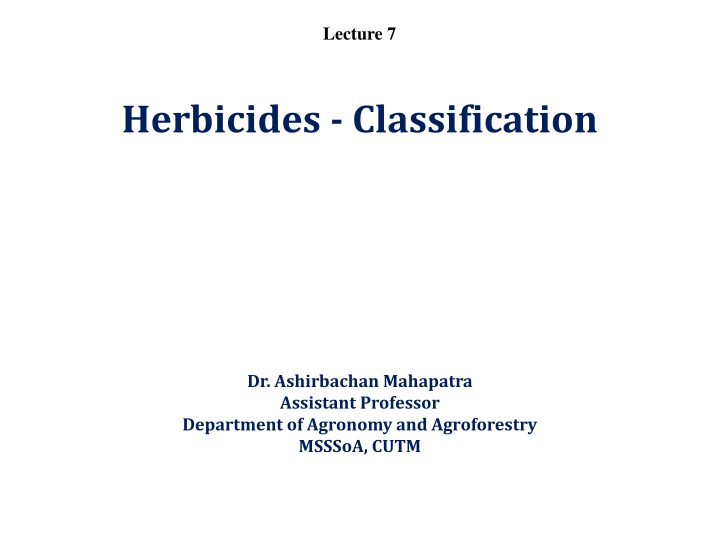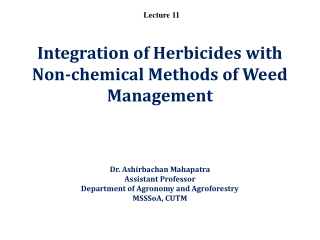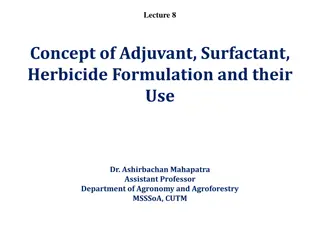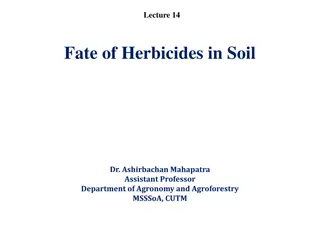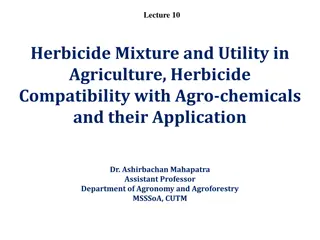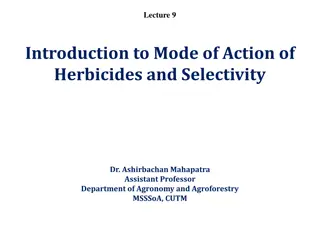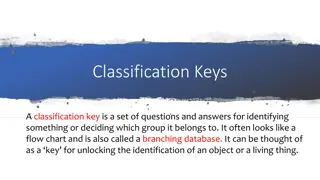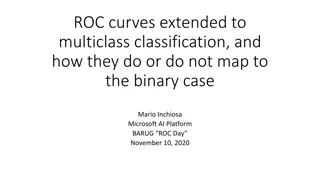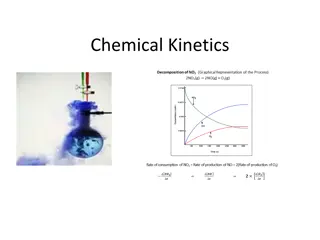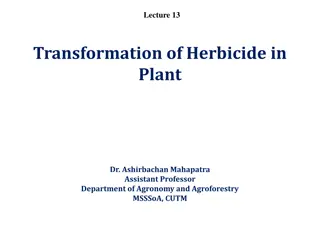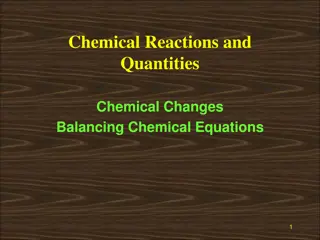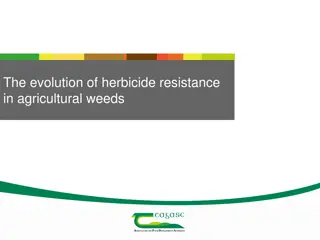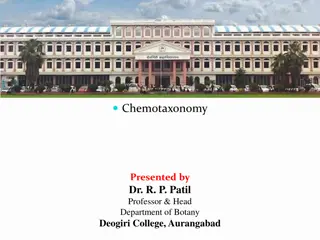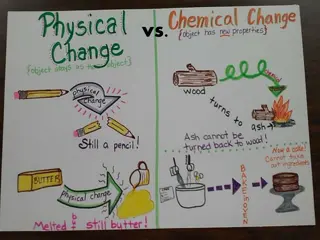Overview of Herbicides Classification and Chemical Nature
Herbicides are classified based on their chemical nature into inorganic and organic herbicides. Inorganic herbicides do not contain carbon atoms, while organic herbicides contain carbon atoms. They are further categorized into 31 classes, each with distinct properties and modes of action. This classification system helps in understanding the behavior of herbicides in soil and plants. The list provides examples of herbicides in each class, showcasing the diversity and range of available products.
Download Presentation

Please find below an Image/Link to download the presentation.
The content on the website is provided AS IS for your information and personal use only. It may not be sold, licensed, or shared on other websites without obtaining consent from the author.If you encounter any issues during the download, it is possible that the publisher has removed the file from their server.
You are allowed to download the files provided on this website for personal or commercial use, subject to the condition that they are used lawfully. All files are the property of their respective owners.
The content on the website is provided AS IS for your information and personal use only. It may not be sold, licensed, or shared on other websites without obtaining consent from the author.
E N D
Presentation Transcript
Lecture 7 Herbicides - Classification Dr. Ashirbachan Mahapatra Assistant Professor Department of Agronomy and Agroforestry MSSSoA, CUTM
Classification based on chemical nature Herbicides are primarly grouped into inorganic and organic herbicides. Inorganic herbicides do not contain carbon atoms in their molecules. They were the first chemicals used for weed control. Arsenic acid, arsonous acid, sulphuric acid are acid type of inorganic herbicides. Where as sodium arsenate, sodium chlorate, copper sulphate etc are inorganic salts. Organic herbicides: These herbicides contain carbon atoms in their molecules. They may be oils or non oils. Eg. diesel oil, xylene type of aromatic oils. Majority of present day herbicides are non oils. There are about 150 herbicides are available. They differ each other like behavior in soil, plants, mode of action etc. based on this chemical nature; the herbicides are grouped into 31 classes.
Sl.No 1 2 3 4 5 6 7 8 9 Group Aliphatic acids Amides Benzoics By Pyridillums Carbamates Thiocarbamates Dithiocarbamates CDEC, Metham Nitriles Dintroanilins Herbicides Dalapon, TCA, Glyphosate, Methyl bromide Cacodylic acid ,MSMA,DSMA Alchlor, Butachlor, Propachlor, Metalachlor, Diphenamide, Propanil 2,3,6, TBA, Dicamba, tricamba, Chloramben Paraquat, Diquat Propham, Chlorpropham, Barban, Dichlormate, Asulam Butylate, Diallate, EPTC, Molinate, Triallate, Benthiocarb, Metham Bromoxynil, Ioxynil, Dichlobenil Fluchloralin, Trifluralin, Pendimethalin, Nitralin, Isoproturon 10 11 12 13 14 15 16 Phenols Phynoxy acids Traizines Ureas Uracils Diphenyl ethers Aryloxyphenoxy propionate Diclopop , Fenoxaprop-p, Quizalofop-p, Haloxyfop- p, Fluazifop-p Dinoseb, DNOC,PCP 2,4-D, 2,4,5-T, MCPA, MCPB, 2,4-DB, Dichlorprop Atrazine, Simazine, Metribuzine, Amytrin, Terbutrin Monuron, Diuron, Linuron, Metoxuron, Isoproturon, Methabenz thiozuron Bromacil, Terbacil, Lenacil Nitrofen, Oxyfluorfen, Nitrofluorfen
17 18 19 20 21 22 23 24 25 26 27 28 29 30 31 Cyclohexanedione Sethoxydim, Clethodim, Tralkoxydim, Cycloxidim Imidazolines Imazapyr, Imazamethabenz, Imazaquin, Imazamax, imazethapyr Isoxazolidinones Clomazone Oxadiazoles Oxadiazon Oxadiazolides Methazole N-phenyl-phthalamides Flumiclorac Phenyl pyridazones Sulfentrazone Phthalamates Naptalam Pyrazoliums Difenzoquat, Metflurazone Picolinic acids Pyridine Picloram , Dithiopyr, Pyrithiobac, Fluridone, Thiazopyr Quinolines Quinclorac Sulfonylureas Bensulfuron, Chlorimuron, Metsulfuron, Sulfosulfuron, Triasulfuron Triazolinones Pyridates Cineoles Cinmethylin Others Pichloram, Pyrazon, Endothal, Oxadiazon, Amitrole, Anilofos
Classification based on methods of application of herbicides Methods of application of herbicides are decided largely by their modes of action and selectivity. Important methods of application of herbicides to crop and non-crop lands are given, as follows 1. Soil-Active Herbicide A soil-active herbicide is one that is applied primarily to the soil rather than to the vegetation. Inside the soil it kills weeds as they germinate or inhibits sprouting of their rhizomes, stolons, and tubers. Therefore, in crop fields a soil-active herbicide eliminates early weed-crop competition for the period of 4 to 8 weeks, depending upon the herbicide and its rate used. The soil-active herbicides are applied at the times of planting of crops, and to the weed free inter-rows of established crops to obtain extended period of weed control. Eg simazine, alachlor, trifluralin, and EPTC. On non-crop lands, the soil-active herbicides used are soil sterilants and fumigants. The technique has proved effective in controlling perennial weeds like Cyperus rotundus and Convolvulus arvensis. Eg Carbamate and nitralin herbicides, The immediate use of the technique is probably in orchards and vineyards, besides certain wide-row crops like sugar beet and tobacco.
Surface Application Soil active herbicides are applied uniformly on the surface of the soil either by spraying or by broadcasting, where they may be either left undisturbed or incorporated into the soil physically. Eg many substituted triazines, urea, and anilide herbicides. There are other soil- applied herbicides which must be incorporated into the soil to prevent their rapid volatilization and/or photodecomposition losses. Eg EPTC and fluchloralin, trifluralin and nitralin Sub-Surface Layering It is the application of an herbicide in a concentrated band, about 7-10 cm below the soil surface. Band Application The band application of a herbicide constitutes its application to a restricted band along the crop rows, leaving an untreated band in the inter-rows. The band application of herbicides is primarily a cost saving device since it reduces the quantity of herbicide in the ratio of the treated band width to the crop row width. Soil Fumigation: Herbicides used for fumigation are called as fumigants. Depending upon the nature of the soil fumigant, it can be applied either (1) by soil injection (chloropicrin) (2) by releasing it under sealed, plastic covers (methyl bromide) or (3) by direct soil surface application (Metham). Herbigation Application of herbicides with irrigation water both by surface and sprinkler systems. In India farmers apply fluchloralin for chillies and tomato, while in western countries application of EPTC with sprinkler irrigation water is very common in lucerne.
Methods of Application of Foliage-Active Herbicides A Foliage-active herbicide is applied to weeds after their emergence from the soil. They are absorbed by the plant foliage and these are translocated to the other plant parts. Eg 2,4,5-T, paraquat, diquat, MCPB, amitrole, and herbicidal oils are common examples of foliage-active herbicides.There may be some herbicides that are both soil-active and foliage-active, for example, 2,4-D, picloram, and atrazine. Blanket Application: Blanket (or over-the-top) it is uniform application of herbicides to standing crops with disregard to the location of the crop plants. Only highly selective herbicides are applied by this method, e.g. 2,4-D in wheat. rice , MCPB in pea, 2,4-DB in Lucerne, and picloram in sugarcane cf. surface application of herbicide. Directed Spraying: It is the application of herbicide to weeds, which are growing in the inter- rows of crop avoiding the crop foliage as much as possible. One important pre-requisite of directed spraying is that farmer must get his row crops well grown over the weeds at the time of treatment. Orchards and plantations are good venues of directed herbicide sprays. Usually, the directed spraying is adopted with herbicides that are partially selective to the treated crops. Spot treatment: Spot treatment is the application of herbicides to small patches of weeds, leaving the weed-free gaps untreated. This is used for treating patches of noxious, perennial weeds in certain crop fields with potent herbicides. Spot treatment is of value also in the non-crop areas to prevent wastage of herbicide in the weed-free spaces.
Protected Spraying: Non-selective herbicides can be employed to obtain selective weed control in distantly planted vegetables and ornamentals either by covering the non-target plants before application of the herbicide with plastic or metallic covers or by spraying herbicide underneath a hooded or shielded sprayer. This method is called protected spraying. Bermudagrass reinfesting row middles following planting or after early cane harvest can be controlled in mid-October with glyphosate products applied underneath a hooded or shielded sprayer that prevents spray contact with sugarcane foliage . Methods of treating brush and trees Brush weeds and unwanted trees are treated with herbicides by different methods,. Foliage treatment is the most common method of treating brush. i) Foliage treatment: when the brush leaves are fully expanded, growing actively. Ground sprayers can cover up to 2.5 m high brush ii) Basal bark treatment: A better method of dealing with tall brushes Basal 30 cm of stem bark. is peeled off then spraying is done to the point of liberal run-off iii) Cut stump treatment: It comprises sawing of the tree above the ground followed by liberal application of the herbicide on the cut surface iv) Other ways by which the concentrated herbicides are applied to unwanted trees are, frill, notch, and injection methods. The frills and notches are made with sharp tools into the sapwood at convenient stem height and filled with herbicides. The herbicide injections are made into holes made in the tree trunk. Usually, one herbicide injection per 2.5 cm stem thickness is adequate. The frill, notch, and injection methods are adopted on thick stem trees which are 8 cm or more in diameter.
Other methods of Herbicide Application D.C.A.(Direct Contact Application): D.C.A includes all techniques involving wiping, rubbing, and smearing of herbicide onto the target plant surfaces. It may be achieved by using herbicide wax bars, herbicide cloth mulch, herbicide rouging gloves, etc. The herbicide laden wax bars are dragged against weeds growing much taller to the crop plants. Herbicide cloth mulches are spread in the crop inter-rows. The rouging gloves carry arrangement to smear herbicide onto the weed gripped by the worker. Many other ways of DCA of herbicides can be designed to suit specific situations. Soil injection: Herbicides like ethylene, carbon bisulphide and vernolate are applied by soil injections, at prescribed spacings, before planting of the crops.
Classification based on time of application of herbicides 1. Pre-plant treatment An herbicide treatment made any time before the crop is planted is called a preplant treatment. There are two types of preplant treatment, namely (a) preplant desiccation and (b) preplant incorporation treatment. In the former method herbicides are applied to destroy the standing vegetation as an aid to seedbed preparation. Field preparation is done after the application. eg: Paraquat, Glyphosate. In the preplant incorporation method (PPI), on the other hand , herbicides are mixed with the soil in weed-free seed-beds to obtain residual control of weeds during the crop season. eg Fluchloralin , Pendimethalin, Trichloralin and Alachlor 2. Pre emergence treatment Application of herbicides soon after planting of a crop is called pre emergence treatment. But sometimes, a pre emergence treatment is further specified as pre emergence to weeds, when it may be applied to standing, weed free crop rows, benthiocarb, atrazine in maize, diuron in cotton pendimethalin, butachlor (pre-emergence selective herbicide).
3. Post emergence treatment Post emergence treatment is the application of herbicide after the emergence of both the crops and the weeds. But when the weeds grow before the crop plants have emerged through the soil, and these are knocked with an herbicide, the treatment is called early post emergence treatment. Herbicides used for the early post emergence treatment are usually non-residual types, e.g. paraquat and diquat. Propanil in Rice at 25 DAT 2,4-D at 30 DAT of Paddy.Isoproturon both pre and post emergence in wheat Lay-by application: It is the application of herbicides after the last cultivation in crops, such as, after ridging in sugarcane and cotton.
Based on selectivity/Mode of action 1. Selective herbicide: It is one that will kill some plant species when applied to a mixed plant population, without causing serious injury to the other species. Selective herbicides are used in crop areas, lawns, gardens, and grasslands. 2,4-D, atrazine, EPTC, trifluralin, alachlor, butachlor, fluchloralin and pendimethalin are selective herbicides used on crop land. 2. Non-selective herbicide It is one that kills plants without regard to species, for example, paraquat, Diquat, sodium chlorate, weed oils, and acrolein. The non-selective herbicides are employed for general vegetation control on industrial sites, fallow land, and in aquatics and tennis courts.*Certain selective herbicides when applied at high rates, can act as non-selective plant killers, for instance, simazine and diuron.
Based on translocation/mobility 1. Contact herbicide kills plants by coming in contact with the plant tissue rather than as a result of its translocation. Thus, a contact herbicide applied to the foliage of a plant will not kill its roots, though in simple annuals the roots of the treated plants may die because they were deprived of their shoots. The established weeds will regrow from their crown buds, roots, or rhizomes, shortly after treatment with a contact herbicide. Some common contact herbicides are paraquat, diquat, Propanil, and petroleum oils. 2. Translocated (systemic) herbicide moves within the plant from the point of treatment to its other parts, to variable extent. It often kills the entire plant even if only a portion of the plant was treated with the herbicide. Eg Glyphosate.*Therefore, the translocated type of herbicides is of particular importance in controlling the perennial weeds. The translocated herbicides can be applied as low volume sprays to control annual weeds because they need not wet the entire plant foliage, where as the contact herbicides which must drench the weeds fully for bringing about their effective kill. Some herbicides may exhibit both, contact and translocation activities. For example, atrazine is a translocated herbicide when absorbed by the weed from the soil, but a contact herbicide when it is sprayed on the plant shoots.
Based on residual effect 1. A residual herbicide maintains its phytotoxic effects in soil for considerable time after its application. This residue period may be three to four weeks in some herbicides, such as 2,4- D and EPTC, and much longer, up to several months, in others. 2. A non-residual herbicide is inactivated in soil immediately, or within a few days, after it reaches the soil, Paraquat, diquat, amitrole, DSMA, and weed oils are non-residual or very short persistence herbicides. The non-residual herbicides are good for a quick knock-down of the existing weeds. They do not provide any extended period of weed control..
Based on spectrum of application 7.7.1 A narrow spectrum herbicide, upon application to a mixed population of weeds, proves active on one, or a very limited number of species. Most of the other weed species remain tolerant to such herbicides. The narrow spectrum herbicides are very useful against specific noxious weeds. Metoxuron, difenzoquat and diclofop are very successful examples of narrow spectrum herbicides. These are widely used against specific weeds like Phalaris minor and Avena fatua. Soil sterilants and fumigants *A soil sterilant prevents the growth of plants when present in the soil*. The temporary soil sterilants sterilize the soil for up to 16 weeks, whereas the permanent soil sterilants remain active for two or more years. The temporary soil sterilants are usually volatile compounds which leave the soil in vapour form after a few days to a few weeks of application. During this period these are supposed to have killed all live plant parts in the soil. Such soil sterilants are also called soil fumigants. E.g. MB, metham, and dazomet are good examples of soil fumigants used in agriculture and horticulture for the treatment of seedbeds and pot soil. Permanent soil sterilants used in causing bare ground in industrial and other non-crop areas for one or more seasons. Sodium chlorate, substituted ureas, several symmetrical triazines, arsenics, and borates are the major permanent soil sterilants in use currently.
